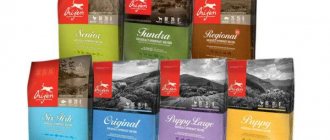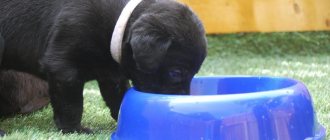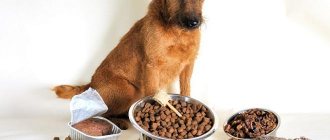At what age can you start feeding puppies complementary foods?
In general, experts recommend starting feeding puppies at one month of age. But this is true if the lactating bitch has enough milk. If it is a small dog, for example, a Yorkie, and there are many puppies, then there will be little milk. Then the breeder will have to intervene when the babies are about 20 days old.
Fact! The average fat content of dog milk is 9.5%, while that of cows is only 3.3%.
It is best to start feeding puppies with milk from three weeks of age. Ideally, take goat, as it is fattier. If this is not possible, you can use regular cow milk. For nutritional value, you can add one beaten quail egg per glass.
How to wean puppies off their mother's milk
The bitch actively feeds the babies up to six to eight weeks of age. Then the amount of milk begins to decrease, so the puppies simply have no choice but to switch to the food provided by the owner. Well, he should know not only when to start feeding the puppies, but also how to do it correctly.
What and how to give puppies after one month of age
When the puppy turns one month old, it’s time to introduce him to solid food. Moreover, this applies to dogs, regardless of age - even a tiny pug, a miniature Spitz, or a fairly large Labrador or German shepherd. It is necessary to feed the puppies so that they receive enough nutrients, because there is no longer enough mother's milk for everyone.
To begin with, it is best to use lean meat (chicken, rabbit, veal), finely chopped or minced. You can also use cottage cheese (but not the cheap cottage cheese product). Some breeders add eggs to the cottage cheese from the first feedings - one quail per 200 grams or one chicken per 700 grams.
Healthy! It is advisable to wash eggs before eating to reduce the risk of poisoning or parasite infection.
Company always tastes better
Large breed dogs
The most popular can be considered the German Shepherd. Complementary feeding of shepherd puppies begins from 18-20 days of life. These puppies are quite large and require a lot of calcium and nutrients to grow and develop. From this time on, calcined cottage cheese can be introduced. It performed very well in the combination “cottage cheese - milk - raw egg” or “cottage cheese - egg - carrot juice”. From day 22 you can add lean beef. To do this, it is scraped or ground in a blender. A good option would be a mixture of milk, cottage cheese and minced meat.
From about 26 days of life, milk porridge can be introduced into the diet. Cereals must be ground in a coffee grinder. Start with one cereal, and when your baby’s stomach gets used to it, you can add the next one.
What should be the portion size for a puppy?
Of course, the breeder must know when to feed the puppies and how much food to give. But this question is quite complex - it is simply impossible to give a universal scheme for months and weeks. Primarily due to the size of the dog. It is quite clear that a Chihuahua puppy and an Alabai puppy at the same age need different children's portions.
Features of feeding small, medium, large breeds
In general, experts believe that a puppy under the age of six months should eat an amount of natural food equal to 7% of its own weight. Moreover, this applies equally to small Yorkshire terriers and agile huskies or lazy Caucasian shepherd dogs.
True, there are certain nuances depending on the size. For example, small dogs aged two months need to be fed six times a day. But larger puppies prefer to eat more, but less often - it is better for them to be given food five times a day.
Note! It is important to monitor your puppy's behavior. Often you can tell from it whether he has enough food, too much or not enough.
How much food does a puppy need?
For medium and large breed puppies, there is a clear formula: they need 5 to 8% of their body weight. Moreover, this portion is adjusted once a week. But the main guideline remains the condition of the puppy. He shouldn't get fat or look thin. You can focus on the ribs. They should not bulge, but upon palpation they can be easily felt. If the puppy is cheerful, runs around a lot and is interested in the world around him, he will definitely have a good appetite. At the same time, it is necessary to provide him with high-quality food, complete sources of all necessary nutrients.
How to create a diet from natural food
As mentioned above, at the age of 2 months the diet should be based on cottage cheese, meat and eggs. Already at the age of 3 months, it can be enriched with porridges - they are prepared in water or meat broth. Millet, buckwheat and oatmeal are suitable. After another month, you can add some vitamins to the porridge - chopped carrots, zucchini and pumpkin. On such a diet, a puppy can live comfortably for up to six months or a year, and then its diet gradually transforms into the diet of an adult dog.
The number of feedings per day and how to understand whether the puppy is hungry or full
The number of meals per day depends on age. Experts consider the following system optimal:
- at 2-3 months – 5-6 times;
- from 3 to 4 months – 4-5 times;
- from 4 to 6 months – 3-4 times;
- from 6 to 10 – 3 times;
- from 10 months and older – 2 times.
It is very important to monitor what behavior the puppy demonstrates. If he carefully licks the cup, whines and does not move away from the feeding place, then the portion needs to be increased by 5-10%. If he doesn’t finish everything, leaving some in the bowl, then too much food is given - the diet should be reduced.
Meat is the basis of dog nutrition
Good puppy feeding: basic points
When choosing the type of dog food (dry food or natural food), follow the rule - do not overfeed! Overeating can have serious consequences. It’s not worth growing your pet’s stomach to a large size; overfeeding will lead to poor health, joint problems, which is especially important for large breed dogs), and diseases of the internal organs.
When can you feed puppies? Before bedtime, if the dog is hungry. Offer your pet milk porridge, pamper it with meat, but do not make the ritual daily.
Feeding the puppy natural food
Many owners choose how to feed their dogs natural products. The reasons for choosing are as follows:
- natural food is cheaper than buying ready-made food;
- natural food gives confidence in the quality of food.
There are also a lot of disadvantages to feeding “human” food: you have to often go to the store and prepare food, because during the growth period the animal eats a lot.
The main motto is “Only natural”, isn’t the prospect of standing near the stove for a long time scary? We recommend paying attention to the freshness of the products. Meat that tastes good at a low price will play a cruel joke on the health of an eared baby. Poisoning from low-quality products is not uncommon. Remember that a puppy is a small child, so it is important to take food responsibly.
Second rule: you cannot feed your dog from the table! Signature aromatic borscht, seasoned with sour cream, cabbage rolls prepared according to a family recipe will appeal to people, but not to the puppy, and will cause problems with his well-being!
What can you feed your little friend?
1) Milk
A puppy's diet up to 4 months includes milk. This product provides vital elements for the growth and development of a foolish baby. Offer it raw and cook milk porridge. Not every milk will do. Choose goat, you can’t go wrong - there are rarely allergies to it, and it is easier to accept by the body. Having trouble finding a goat? You can give cow's milk, but dilute it with water to avoid intestinal upset.
Closer to six months, the amount of milk is reduced and gradually eliminated, replacing it with fermented milk products.
2) Dairy products
Proper feeding of puppies consists of many factors, including fermented milk. Good digestion and enrichment of the body with calcium are a wonderful reason to buy your pet cottage cheese, kefir, and low-fat sour cream. Whey is one of the most useful products, containing a huge amount of useful substances. According to the degree of usefulness, hard cheeses are distinguished, which are easy to use as a reward during training.
3) Meat
It must be present in the daily menu, at least 40% of the total diet. You can give raw, frozen, boiled, scalded meat. The priority is still given to raw meat, because the predator is being raised. What species can be included in a puppy's diet?
- skinless chicken;
- turkey;
- veal;
- beef;
- horsemeat;
- offal (cooked, raw).
The meat is given, cut into cubes, but not minced.
4) Fish and seafood
Offer it to your puppy twice a week. Give preference to sea fish (river fish is often hazardous to health): squid, shrimp, mackerel, hake, pollock. Do not mix with meat feedings.
5) Vegetables
Teach your baby to vegetables: they contain many vitamins. Mix with cottage cheese, porridge, grind on a fine grater, serve as a puree or simmer - and you have delicious dishes that are easily digestible. Pumpkin, carrots, zucchini, beets, and greens (onions, parsley, spinach) are useful.
6) Berries, fruits
Undoubtedly, they are useful, so feel free to include them in the diet, especially if your dog likes to crunch on an apple. Beware of fruits with pits containing prussic acid. It is not advisable to give bananas; the fruit will cause rapid weight gain. Grapes and currants cause bloating and the accumulation of harmful substances in the body.
7) Cereals
Let's make a reservation right away: porridge for puppies is excluded as the main element of the menu. Cereals are good for digestion, but you should not feed a growing dog only cereals. And as an addition to a dairy-meat diet, they are ideal.
What kind of cereals will your furry baby like?
- semolina;
- buckwheat;
- rice;
- oatmeal
When adding a certain type of porridge to the menu, monitor the puppy’s condition; if there is an intestinal disorder, exclude this type for a while.
 Eggs
Eggs
They serve as an excellent source of protein; it is recommended to include egg yolk in the diet 2 times a week. The dog will like omelettes and eggs in their pure form. Quail eggs are ideal.
Feeding puppies food
How to properly feed a puppy with dry food is something every owner will think about when they decide to make food the main way of feeding their little four-legged friend. Many people worry that dry food contains few important substances for harmonious growth and development. Manufacturers year after year develop food that can satisfy a dog’s hunger, provide the animal with all the vital vitamins and minerals, and give the animal smooth, shiny fur and strong teeth. Dry food is properly balanced, food is easy to give, following the instructions for the daily intake.
How to properly feed a puppy?
It is recommended to give the baby food in a soaked form. Thirty minutes before the intended feeding, the granules are poured with warm water to swell. The use of broths for this purpose is excluded.
How many times should you give your puppy dry food per day? Follow the recommendations on the packaging. The dose should not be exceeded: there is a high risk of overdosing on nutrients. It is important for the owner to know that dry food is very high in calories and differs from natural food, so the dog must be given granules strictly according to the instructions.
There are situations that require switching a puppy from natural food to commercial food. This should be done gradually, without sudden jumps, consult your veterinarian first.
The Zoomix store offers dry food of existing classes: from economy options to super premium. We advise you to look for the following brands:
- Hill's;
- Royal Canin;
- Eagle Pack;
- Purina Proplan;
- Genesis;
- Diamond.
- Popular foods
- New
- Stock
GO grain-free food for puppies and dogs with sensitive digestion with turkey
GO grain-free food for puppies and dogs with sensitive digestion with turkey
Price: from 1340
GO grain-free food for puppies and dogs with sensitive digestion with fresh duck
GO grain-free food for puppies and dogs with sensitive digestion with fresh duck
Price: from 1267
Dry puppy food PURINA PRO PLAN Small & Mini Puppy
Dry food for puppies PURINA PRO PLAN Small & Mini Puppy Complete dry food for puppies of small and toy breeds Purina® PRO PLAN® Small & Mini Puppy with…
Price: from 380
Dry food GO (Go) for puppies and dogs with salmon and oatmeal
Dry food GO (Go) for puppies and dogs with salmon and oatmeal
Price: from 1065
Dr. Clauder's. Cat food with game - canned (415g)
Dr. Clauder's. Cat food with game - canned (415g) Complete balanced nutrition for cats. Manufactured in Germany. Ingredients: Meat and meat...
Price: from 80
Frontline Combo for dogs from 2 to 10 kg
Frontline Combo for dogs from 2 to 10 kg Frontline (Frontline) - a new generation remedy against ectoparasites contains a new formula: fipronil - an active and effective drug...
Price: from 492
CLAN CLASSIC canned food for dogs, Pieces in sauce with rabbit and liver (1250g)
CLAN CLASSIC canned food for dogs, Pieces in sauce with rabbit and liver (1250g)
Price: from 183
Canned food Four-legged gourmet GOLDEN LINE Natural chicken in jelly
Canned food Four-legged gourmet GOLDEN LINE Natural chicken in jelly Ingredients: chicken, jelly, salt, drinking water. Nutritional value (per 100 g of product): protein - 8 g, fat - 16 g, moisture -...
Price: from 92
Ever Klin Multiple Cat Litter for multiple cats
Ever Klin Multiple Cat Litter for multiple cats
Price: from 961
Canned food for cats LECHAT. Meat pieces with duck and liver (400g)
Canned food for cats LECHAT. Meat pieces with duck and liver (400g) Complete food for cats.. Made in Italy. Ingredients: meat and meat products 45% (duck no less...
Price: from 60
Berkeley Turkey with Cheese
Berkeley Turkey & Cheese Complete Canned Dog Food. Tender turkey meat of the best quality with cheese, olive oil and...
Price: from 195
Dr.Clauder's Dietary food for dogs IRD “Intestinal Diet” (200g and 400g).
Dr.Clauder's Dietary food for dogs IRD “Intestinal Diet” (200g and 400g). Therapeutic complete food diet for dogs to compensate for poor digestion. Main nutritional…
Price: from 137
ALL PUPPY FOOD
Using vitamins in puppy food
Experienced breeders know how important vitamins are for a growing body, so they do not forget to add them to the food at the age of 2 months. The easiest way to purchase it is at the Trivit pharmacy. This is a mixture of vitamins A, E and D3 - the most important for dogs.
In addition, if you have to work with a large dog, you can add to the diet not only fermented milk products, but also preparations containing calcium - chalk or calcium gluconate. If this is not done, the grown pet may have problems with the musculoskeletal system.
What can happen if you feed your puppy incorrectly?
Alas, not all breeders know what to feed puppies at 3 weeks and later. As a result, they commit many serious violations that can cause serious harm to the pet.
For example, if feeding is insufficient or unbalanced, the puppy will simply grow slowly, and various diseases may develop that affect the skeleton, sensory organs, and internal organs. Well, with excess feeding, on the contrary, the puppy begins not only to grow, but also to gain excess weight. Because of this, the puppy's fragile heart begins to work too intensely, and this is fraught with heart failure and death at a young age.
So, moderation and a balanced diet is the key to the normal development and good health of the dog.
How to teach a puppy to eat from a bowl
The procedure is quite simple. Often, puppies, attracted by the tasty smell, eat from the bowl themselves. If this does not happen, you can lightly poke your pet’s nose into the treat - he will be forced to lick his nose and lips, feel the taste of the food and start eating.
On a note! When feeding natural food, you need to make sure that the cup (especially if a metal one is used) is not hot - if it gets burned, the puppy will retain a dislike for the bowl for the rest of its life.
At this stage, it is important not to scare your pet. Otherwise, he will simply be afraid to eat from a cup, and this will cause a lot of problems for the owner.
You can't yawn in a big family
Understanding all the intricacies of feeding a puppy is not that difficult. Therefore, nothing will prevent you from providing your pet with tasty and healthy food from the first weeks of life.
How to feed a puppy with ready-made food
From 3 weeks
Feeding a small puppy begins with wet food. It is soft and easy to swallow, so your baby will not damage his gums with prolonged chewing. Wet food has fewer calories than dry food and makes you feel full faster. Therefore, the puppy will eat it often and little by little, which corresponds to age requirements.
From 1 month
From the moment the puppy's first teeth erupt, dry food can be offered. At this age, the gums are still tender, so it is recommended to select a product with a texture suitable for chewing by baby teeth. Dry food can be mixed with wet food first or moistened with warm water.
From 9–10 weeks
From this age, puppies of any breed can be completely switched to dry food. It is important to ensure that your dog always has access to fresh and clean water. When feeding dry food, it is necessary that the puppy does not lack fluid.











